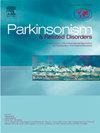帕金森氏症的手部肌肉力量:肌肉减少的附带现象还是有意义的生物标志物?
IF 3.4
3区 医学
Q2 CLINICAL NEUROLOGY
引用次数: 0
摘要
肌肉减少症,与年龄相关的肌肉质量和功能的损失,已经在帕金森病(PD)中报道。虽然握力是肌肉减少症的关键标志,与帕金森病的风险和进展有关,但其与潜在的神经退行性过程的关系尚不清楚。本研究探讨PD患者握力是否受损,并反映疾病严重程度或多巴胺能功能。方法采用[123I]FP-CIT单光子发射计算机断层扫描评估147例PD患者和35名健康对照者的握力、运动症状和纹状体多巴胺转运体(DAT)结合。纵向随访包括84例PD患者进行临床再评估(中位4.1年),40例患者同时进行临床和DAT成像再评估(中位6.2年)。分析握力、运动症状严重程度和多巴胺能功能之间的关系。结果PD患者与健康对照组的平均握力基线值无差异,且与纹状体数据结合无关(p > 0.37)。虽然纹状体DAT结合在PD中下降(每年4.2%,p < 0.001)并与运动功能恶化相关(p = 0.004),但握力与DAT结合下降没有独立关联(p > 0.62)。然而,握力随着运动症状的加重而下降(p = 0.029)。结论轻中度PD患者上肢肌力基本保持不变,不能可靠地反映多巴胺能功能或疾病进展。虽然PD中有肌肉减少症的报道,但握力下降与运动症状进展和数据丢失并行,而不是直接反映疾病过程,这表明它是一种附带现象,而不是独立的病理生理特征。本文章由计算机程序翻译,如有差异,请以英文原文为准。
Hand muscle strength in Parkinson's disease: A Sarcopenic epiphenomenon or a meaningful biomarker?
Introduction
Sarcopenia, the age-related loss of muscle mass and function, has been reported in Parkinson's disease (PD). While grip strength is a key marker of sarcopenia and has been linked to PD risk and progression, its relationship with underlying neurodegenerative processes remains unclear. This study examines whether grip strength is impaired in PD and reflects disease severity or dopaminergic function.
Methods
Grip strength was assessed in 147 PD patients and 35 healthy controls, alongside motor symptoms and striatal dopamine transporter (DAT) binding using [123I]FP-CIT single photon emission computed tomography. Longitudinal follow-up included 84 PD patients with clinical reassessment (median 4.1 years) and 40 patients with both clinical and DAT imaging re-evaluations (median 6.2 years). Associations between grip strength, motor symptom severity and dopaminergic function were analyzed.
Results
At baseline, mean grip strength did not differ between PD patients and healthy controls, and it did not correlate with striatal DAT binding (p > 0.37). While striatal DAT binding declined in PD (4.2 % annually, p < 0.001) and was associated with worsening motor function (p = 0.004), grip strength was not independently associated with DAT binding decline (p > 0.62). However, grip strength declined alongside worsening motor symptoms (p = 0.029).
Conclusion
Upper limb muscle strength remains largely preserved in mild to moderate PD and does not reliably reflect dopaminergic function or disease progression. Although sarcopenia has been reported in PD, grip strength declines in parallel with motor symptom progression and DAT loss rather than directly reflecting the disease process, suggesting it is an epiphenomenon rather than an independent pathophysiological feature.
求助全文
通过发布文献求助,成功后即可免费获取论文全文。
去求助
来源期刊

Parkinsonism & related disorders
医学-临床神经学
CiteScore
6.20
自引率
4.90%
发文量
292
审稿时长
39 days
期刊介绍:
Parkinsonism & Related Disorders publishes the results of basic and clinical research contributing to the understanding, diagnosis and treatment of all neurodegenerative syndromes in which Parkinsonism, Essential Tremor or related movement disorders may be a feature. Regular features will include: Review Articles, Point of View articles, Full-length Articles, Short Communications, Case Reports and Letter to the Editor.
 求助内容:
求助内容: 应助结果提醒方式:
应助结果提醒方式:


